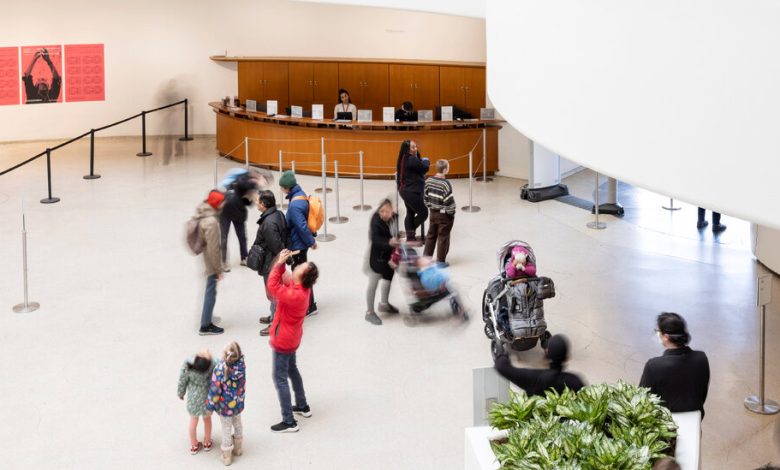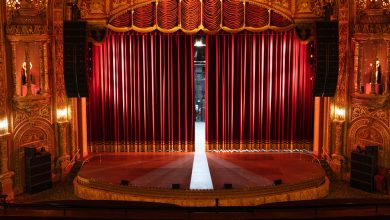The Price of Admission to America’s Museums Keeps Rising

Audience sizes just aren’t what they used to be at the Guggenheim Museum, where membership — once a dependable source of income — has declined by nearly 16 percent since 2019, and attendance in June slumped by 26 percent, from 89,600 to 65,900, over the same time frame. What has increased is the cost of running the institution. A newly unionized work force has bumped up salary expenses, while inflation is driving up the cost of everything from heating to shipping artworks, according to senior museum officials.
At the Guggenheim, leaders said that options for relief were limited after three years of managing the fiscal crisis of the pandemic. And so on Tuesday, the museum raised admission fees, bringing the cost of an adult ticket from $25 to what is becoming the new normal for major museums: $30.
Most cultural organizations are navigating the same uncertainties, asking if the decision to raise fees to offset operating costs — basically maximizing revenues from a smaller core of visitors and art lovers — is worth potentially alienating families and the diverse crowds museums once courted. Museums say it’s typically a measure of last resort.
“As we recover from the lingering financial strain caused by the pandemic, the museum needs to increase its admission prices, which have not been adjusted since 2015,” said Sara Fox, a spokeswoman for the Guggenheim. “The new rates align with those of the museum community in New York City and will help support the operational costs of the museum.”
The trend started last July, according to interviews with nearly two dozen cultural institutions, when the Metropolitan Museum of Art — New York’s largest art museum — raised its adult admission price to $30, a $5 increase. Others followed, including the Philadelphia Museum of Art and the Whitney Museum of American Art, with the Art Institute of Chicago now one of the most expensive tickets at $32 for out-of-state visitors. (The Met is continuing its pay-what-you-wish policy for residents of New York State and the tristate area; the Guggenheim maintains a similar admissions policy for everyone on Saturdays from 6-8 p.m., while the Whitney holds its pay-what-you-wish hours on Fridays from 7-10 p.m.)
Eve Jeffers, chief operating officer at the Art Institute, said that operating costs have increased $6 million over the last five years because of rising inflation and wages. Attendance remains depressed at 25 percent of its prepandemic rates, with 1.2 million visitors in its most recent fiscal year.
“The revenue from the recent price increase goes toward these costs,” Jeffers said. “The increase is necessary for us to remain a world-class institution.”
Marcus A. Harshaw, a senior director of museum experience at the Carnegie Science Center in Pittsburgh, who also teaches museum studies at Johns Hopkins University, said that museums have limited options for an economic fix. Large donations from corporations and philanthropists often come with restrictions that prevent officials from putting the money toward operating costs.
“There are over 35,000 museums in the United States,” he said. “I promise that 35,000 museums are trying to figure out how to earn more income at the gate or raise more contributions from their trustees and communities.”
And he added that museum officials are always looking at the bell curve: “When the price goes up, attendance goes down.”
A recent survey by the nonprofit American Alliance of Museums illustrates the potential for economic risk: It found that only one-third of museums have rebounded to prepandemic attendance levels, with two-thirds experiencing reduced attendance closer to 70 percent. More than half predicted their profits to stay the same or decrease.
“While the museum field is making strides in its recovery efforts, it will take years to fully rebound to prepandemic levels of staffing, revenue and attendance,” said Brooke Leonard, the museum alliance’s interim chief executive and chief of staff.
The economic doldrums also coincided with a great buildup of museums across the United States. Expensive renovations and the construction of new galleries has increased operating costs at organizations like the Philadelphia Museum and the Met Museum — which is spending $70 million to reconfigure the Michael C. Rockefeller Wing with distinct new galleries for sub-Saharan African art, ancient American art and Oceanic art — at exactly the wrong time, leaving officials with higher overhead.
The Cincinnati Museum Center, for example, finished a $212 million renovation in 2018 and was planning to increase its ticket prices in 2020. But the pandemic caused leaders to delay those plans, reasoning that visitors shouldn’t have to pay more for reduced programming at the complex, which includes museums for children, history and science.
“Then you had two factors: our bills were coming in and guests were not,” said Cody Hefner, a spokesman for the center, which eventually raised prices in 2022 to $22 for adult entry — almost a 50 percent increase from the fee of $14.50 nearly a decade ago. Hefner said that leaders are looking at new models to prevent further increases.
“What other revenue streams can we explore?” he asked. “Do we offer birthday packages, camps, date nights and evening hours? We can’t charge more for the same thing.”
Some institutions do say their attendance has fully come back, including the Los Angeles County Museum of Art and the Detroit Institute of Art. Eric Gewirtz, a spokesman for the Detroit museum, said membership has increased by nearly 2,000 subscriptions. But overall, arts organizations have struggled.
Raising ticket prices is so unpopular that many institutions have increased fees during periods of leadership transition to diffuse responsibility, several museum experts said. (Directors of the Whitney and the Guggenheim have both recently retired; at the Philadelphia Museum, Sasha Suda, its newly hired director and chief executive, had less than a year on the job when the museum raised its fees.)
Suda didn’t respond to a request for comment, but the museum spokeswoman, Maggie Fairs, said the admissions revenue would provide “operating support for the care of the world-renowned collections, the development of the internationally recognized exhibitions, and the presentation of public programs and educational activities.”
Harry Philbrick, a museum veteran who is interim executive director of the Fabric Workshop and Museum in Philadelphia, which has free admission, is especially worried that changing attitudes among consumers might lead to an existential crisis for the industry. “Museums are really struggling” in part because the internet has taught younger generations that culture should be cheap, if not free, Philbrick said. “If you are used to getting music basically for free on your phone, why pay for art?” he said. “The museum format is antithetical to how some people are used to getting culture.”
He also drew parallels to the theater industry, where an economic crisis has led major companies — most recently the Public Theater — to lay off staff and announce the staging of fewer productions; others have even shut down.
Museums aren’t there yet, Philbrick explained, but citing conversations with other curators, he said many are planning to limit exhibitions going forward to keep costs down. He added that the decision to raise prices will be painful for his peers: “Each institution has to balance putting up that cost barrier and attracting diverse audiences.”





